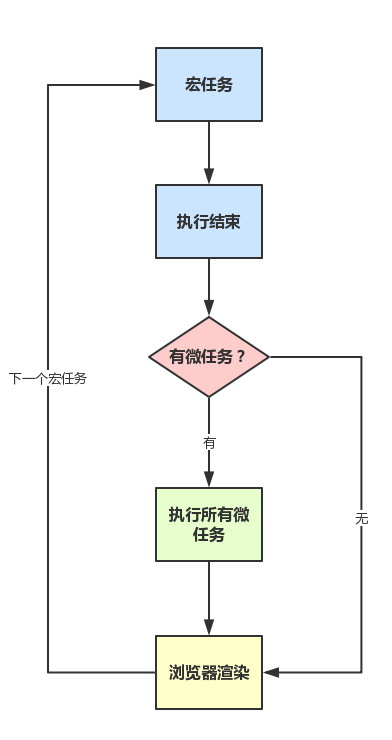异步编程¶
在 JS 引入 Promise 之前,异步编程主要依赖于「回调函数」。
回调函数是一种将函数作为参数传递给另一个函数,并在异步操作完成后执行的机制。当异步操作嵌套多层时,代码变得难以阅读和维护,这种现象被称为「回调地狱」
回调函数的三个特点:你自定义的,你不调用,但最终被执行
function doSomethingAsync(callback) {
// 模拟异步操作,例如网络请求或文件读写
setTimeout(() => {
const result = 'Result of some asynchronous operation';
callback(result); // 异步操作完成后调用回调函数
}, 1000);
}
function handleResult(result) {
console.log('Got result:', result);
// 这里可以继续其他的异步操作,也需要传入回调函数
doAnotherThingAsync(callback);
}
doSomethingAsync(handleResult);
// Result of some asynchronous operation
// Got result:
为了解决回调地狱(callback hell)问题,ES6 引入了 Promise 链式调用,它提供了一种更加优雅的处理异步操作的方法
Promise 对象表示一个可能还没有完成的操作的最终结果,有三种状态:pending(进行中)、fulfilled(已成功)、rejected(已失败)
function doSomethingAsync() {
return new Promise((resolve, reject) => {
// 设置定时器模拟异步操作,例如网络请求或文件读写
setTimeout(() => {
// 假设异步操作成功,并传递结果
resolve('Result of the asynchronous operation');
// 如果异步操作失败,可以使用 reject 回调来拒绝 Promise
reject('Error message');
}, 1000);
});
}
// .then 用于处理成功的操作,会返回一个新的 Promise,继续链式调用
// .catch 用来捕获和处理错误,返回的依然是 Promise
// 最后还可以接 .finally,无论 Promise 的状态如何都会执行
doSomethingAsync()
.then(result => {
console.log('Success:', result);
return doAnotherThingAsync(result);
})
.then(result => {
console.log('Another success:', result);
})
.catch(error => {
console.error('Error:', error);
})
.finally(() => {
console.log('finally')
});
async/await¶
async/await 是 Promise 的语法糖,避免了复杂的回调和链式调用,让异步编程代码更加简洁,易于理解和使用。
在一个函数前面加上 async 关键字 ,将它变为异步函数,它的返回值会被自动包装为一个 Promise,将 .then 和 .catch 链式调用转换为更加直观的 try/catch 块,同时使用 await 等待 Promise 的解决。
async function doSomethingAsync() {
return new Promise((resolve, reject) => {
// 模拟异步操作
setTimeout(() => {
const result = 'Result of the asynchronous operation';
resolve(result);
// 如果需要模拟错误,可以取消下面一行的注释
// reject('Error message');
}, 1000);
});
}
// 假设还有另一个异步函数
async function doAnotherThingAsync(result) {
// 返回一个基于结果的新 Promise
return `Processed ${result}`;
}
// 使用 async/await 语法
async function handleAsyncTasks() {
try {
const result = await doSomethingAsync();
console.log('Success:', result);
const anotherResult = await doAnotherThingAsync(result);
console.log('Another success:', anotherResult);
} catch (error) {
// 捕获并处理异步操作中发生的错误
console.error('Error:', error);
}
}
// 调用异步函数
handleAsyncTasks();
Event Loop¶
https://github.com/Advanced-Frontend/Daily-Interview-Question/issues/7
JS 引擎只执行同步任务,异步任务会有工作线程来执行,当需要进行异步操作,主线程会发一个异步任务的请求,相应的工作线程接受请求。当工作线程完成工作之后,通知主线程,主线程接收到通知之后,会执行一定的操作(回调函数)。
主线程和工作线程之间的通知机制就叫做事件循环。
事件循环可视化:https://www.jsv9000.app
在 JavaScript 的事件循环机制中,任务被分为两种类型:
- 宏任务(Macrotask),又叫 Task,由 JavaScript 引擎线程直接执行的任务,即上图任务队列中的任务,包括
- 整个脚本(main script)
- setTimeout 和 setInterval 的回调
- setImmediate(Node.js环境)等
- 微任务(Microtask),又叫 Jobs,可以看成是插队需要及时处理的任务,是在当前宏任务结束后立即执行的任务,包括
- Promise 的 then 和 catch 的回调
- process.nextTick(Node.js环境)
- MutationObserver的回调(浏览器环境)等
执行步骤:
- 从宏任务队列中取出一个任务来执行
- 执行完这个任务后,执行所有的微任务
- 当微任务队列清空后,进入下一次事件循环,执行下一个宏任务
// 宏任务
console.log('script start'); // 微任务
// 宏任务
setTimeout(function() {
console.log('setTimeout'); // 微任务
}, 0);
// 宏任务
Promise.resolve().then(function() {
console.log('promise1'); // 微任务
}).then(function() {
console.log('promise2'); // 微任务
});
// 宏任务
console.log('script end'); // 微任务
// 输出顺序
/*
script start
script end
promise1
promise2
setTimeout
*/

